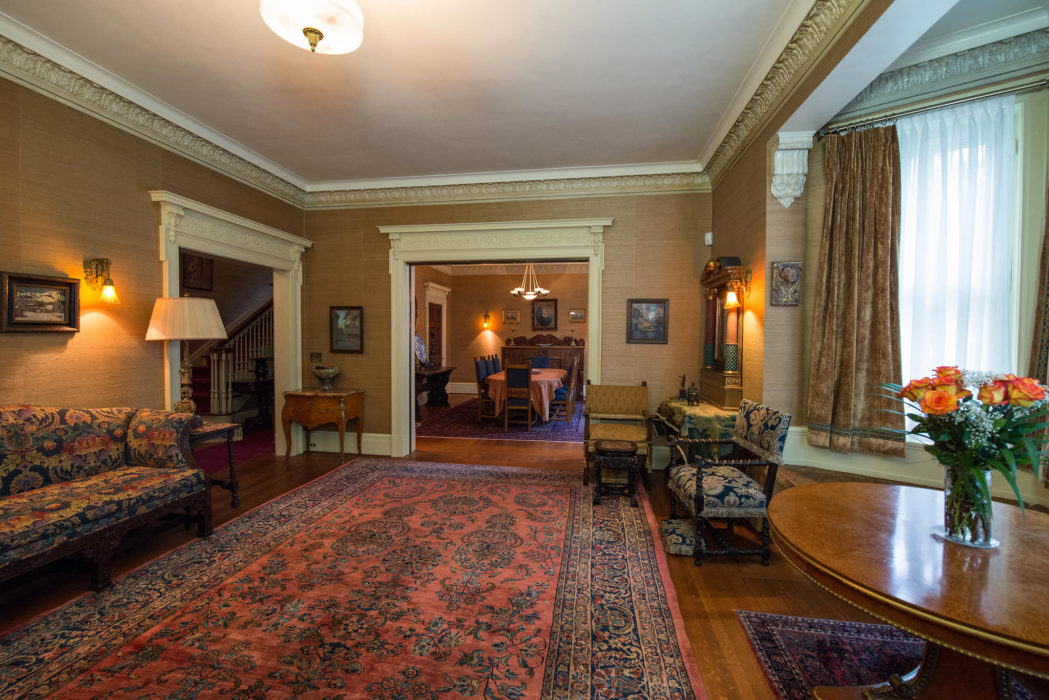MAY MAXWELL’S TWO-YEAR-OLD daughter, Mary, was fast asleep when ‘Abdu’l-Bahá disembarked from his train at Windsor Station in downtown Montreal, Quebec, at about 8:40 p.m. on Friday, August 30, 1912. He and two secretaries were met by May’s husband, architect William Sutherland Maxwell, and taken by carriage to the door of their home at 716 Pine Avenue West. The neighbors were wide awake though, and under the full summer moon caught glimpses of the figure in flowing robes from their windows. That night, after a fire was lit to warm ‘Abdu’l-Bahá, he asked after Mary, but on hearing that she was asleep, declined to wake her. He would sleep just two doors down the hallway from her room, on the second floor, up the winding staircase and at the end of the hall. Before the close of that first evening, he would say of the Maxwell house: “This is my home.”
The train had left Boston at 9 a.m., and ‘Abdu’l-Bahá had crossed the international border separating the United States from Canada as the sun descended in the early evening. But ‘Abdu’l-Bahá’s relationship with the Maxwells began years ago, in the penal colony of ‘Akká. May Ellis Bolles, who had been born in New Jersey, was among the first Westerners to visit ‘Abdu’l-Bahá there in 1899. She was twenty-eight years old, and suffered from a chronic illness, causing her to remain bedridden for months at a time. It was during a particularly bad period of ill health, while her family was living in Paris, that May had first heard of ‘Abdu’l-Bahá. Her godmother, the industrialist Phoebe Apperson Hearst, had organized the trip and stopped over in Paris on the way. She was disturbed by May’s condition. Phoebe’s naturopathic doctor, Edward Getsinger, attended to May, but advised that the healing she needed was only one that his wife, Lua, could provide.

May later recalled that Lua had told her: “There is a prisoner in ‘Akká who holds the key to Peace.” When May discovered that the purpose of the their trip was to see him, she resolved to go with them. She tried to sell her only jewelry to buy a ticket, but when Mrs. Hearst learned of it, she intervened, and bought one for her. Like many of the early Westerners who met ‘Abdu’l-Bahá in ‘Akká, May was spellbound. “Of that first meeting,” she later recalled, “I can remember neither joy nor pain nor anything I can name.”
During the decade between May’s first and second journeys to see ‘Abdu’l-Bahá, she married William Sutherland Maxwell, the Scottish-Canadian architect who was studying in Paris at the time they met. She immigrated to Canada with him, and returned to ‘Akká again in 1909. It was during this time that May told ‘Abdu’l-Bahá she could not have children. ‘Abdu’l-Bahá assured her that this was not true. The next year May Maxwell gave birth to Mary, a daughter.
May’s correspondence with ‘Abdu’l-Bahá was constant; she wrote from a small writing desk situated in the corner of her living room on Pine Avenue. She traveled to New York to meet him off the Cedric on April 11, 1912, and invited him to visit Montreal. He accepted to stay for three days, but this was eventually extended to ten.
May had wanted to host ‘Abdu’l-Bahá in her own home, but her husband was reserved, and shrank from the publicity that hosting him would rouse. The day before ‘Abdu’l-Bahá arrived, however, William had a change of heart. A man of great aesthetic tastes, while pondering the furniture of one of their bedrooms, he declared: “This is not good enough for ‘Abdu’l-Bahá, I’m going right down to Morgans to buy a new set.” It was settled: ‘Abdu’l-Bahá would stay with them.

‘Abdu’l-Bahá’s stay at the Maxwell home provides an intimate window into his relationship with the family. Little Mary was especially attracted to the visitor. On another day, when ‘Abdu’l-Bahá was sleeping on the couch at the foot of his bed, Mary waited until her mother’s back was turned, dashed into his room, climbed up onto his chest, pried open his eyelids with her fingers and cried, “Wake up, ‘Abdu’l-Bahá!”






